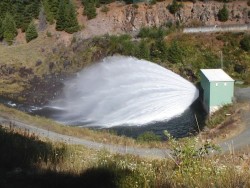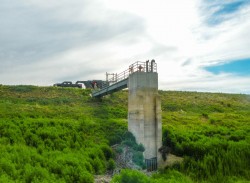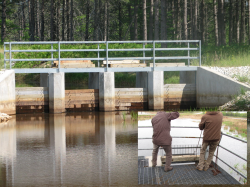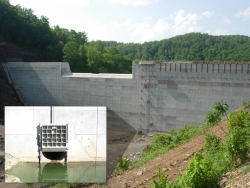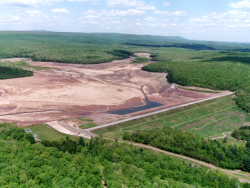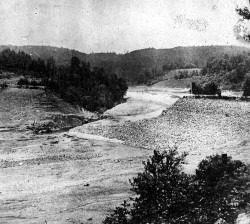Description & Background
The ability to quickly and safely perform reservoir drawdown can be crucial to the protection and preservation of a dam. A reservoir low level outlet works and/or drain system with adequate capacity should be provided in all dams to provide a method of lowering the reservoir level in an emergency within a reasonable period. In several instances, dam failures have been averted by lowering the reservoir in response to emergency conditions detected at dams.
Common types of reservoir drains include gated openings in a riser or control structure, a low level conduit through the dam with a valve or gate at either end of the conduit, or stoplogs located in a control structure. For conduits through embankment dams, it is industry practice to provide a means for upstream closure. In special cases where a reservoir draining system was not incorporated into the original design and construction of a dam, or where the reservoir drainage system is inoperable, siphons or pumps have been installed and used to drawdown the reservoir.
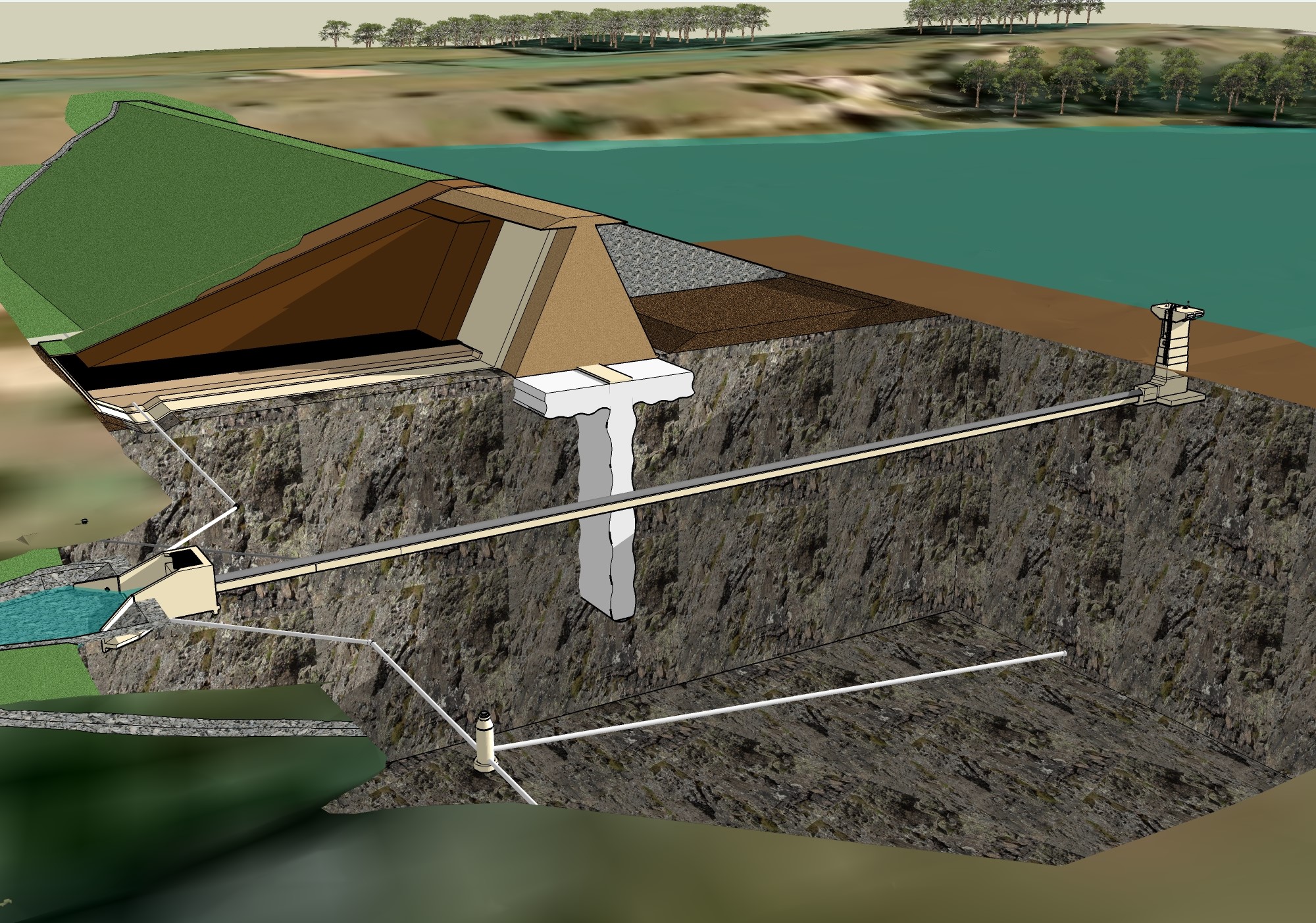
Cross-sectional view of a typical earthen embankment dam with a riser structure and conduit through the embankment. Typically, a riser structure would be used to regulate normal pool level and serve as a low level outlet works should the reservoir need to be drained.
Reservoir drawdown by an outlet works draining system can be necessary in a variety of circumstances. Should serious problems that threaten the immediate safety of the dam occur, the reservoir drain system may be used to lower the reservoir level to reduce the likelihood of dam failure. Examples of such emergencies include clogging of the spillway that could lead to failure of the dam by overtopping, development of internal erosion and uncontrolled seepage in an embankment that could lead to failure of the dam, or a structural problem with a spillway or other critical feature of the dam that could lead to its failure.
Repairs to spillways, embankments, or other dam appurtenances or performance of standard maintenance procedures may also require the drawdown of the reservoir.
In addition to providing a means of drawdown, the outlet works is needed to control the reservoir level during first filling.
References:
Summary
Photos
- In addition to providing means of regulating normal pool level, typical riser structures include means to operate a reservoir drain.
- Four siphons are used as the primary means of reservoir regulation during the rehabilitation of Gilboa Dam on Schoharie Creek in New York state.
- A fixed cone valve provides energy dissipation of discharge through the low level outlet works of this dam.
- When this reservoir is filled, the inclined operator stem of the reservoir drain system will be largely submerged. This type of installation allows for manual operation of a gate valve or sluice gate at dams that do not have riser structures or intake towers.
- Intake tower at an earthen embankment dam.
- Example of a dam with stoplogs used to control the reservoir level.
- Reservoir drain controlled using a sluice gate incorporated within the upstream face of a concrete gravity dam.
- Empty reservoir behind Penn Forest Dam after erosion of the embankment was observed and the drainage system activated in order to lower the reservoir and prevent further failure of the embankment and the resulting downstream consequences.
- The Teton Dam’s reservoir drain system had not been completed when the dam failed during its first filling. In this case, the magnitude of the failure could have been lessened had an operable reservoir draining system been in place.
- Contributing to the failure of South Fork Dam were the lack of a proper drain system and partially blocked spillway.
Videos
Case Studies
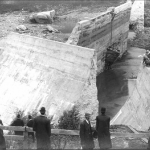
Austin (Bayless) Dam (Pennsylvania, 1911)
Austin Dam (also known as Bayless Dam) was constructed between May and November of 1909 just outside Austin, Pennsylvania, a town of approximately 2,500 people in Potter County.

Hebgen Dam (Montana, 1959)
Just before midnight on August 17th 1959 in southwest Montana, in the vicinity of Yellowstone National Park, a Mw 7.3 earthquake caused an estimated 36 to 43 million cubic yard rockslide to rapidly cross the Madison River and continue up the opposite canyon...
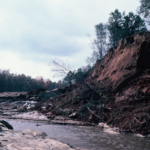
Kelly Barnes Dam (Georgia, 1977)
Kelly Barnes Dam was located approximately a half mile upstream (north) of Toccoa Falls Bible College in Stephens County, Georgia. Toccoa Falls, a 186-foot-high waterfall, was located between the dam and the college. The dam site was originally the location...

Machhu Dam II (Gujarat, India, 1979)
On August 10, 1979, monsoon storms poured over Gujarat, India. Monsoon rainstorms were not uncommon in this part of India, but as the storm increased it was clear this was larger than the usual storm. Flow began to increase down the Machhu river, first hitting Machhu Dam I and then turning downstream to Machhu Dam II...
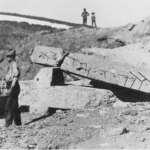
Mammoth Dam (Utah, 1917)
In 1902 the Price River Irrigation Company proposed to build a dam on Gooseberry Creek about 80 miles SE of Salt Lake City, UT. It would be an earthfill structure with a height of 100 feet. An outlet tunnel through bedrock...

Marshall Lake Dam (Colorado)
Routine inspections of Marshall Lake Dam in the early 21st century were relatively uneventful. The 75-foot-tall, 2,400-foot-long high hazard earth embankment dam had relatively flat slopes...

Palagnedra Dam (Switzerland, 1978)
Palagnedra Dam was constructed between 1950 and 1952 on the Melezza River located in the country of Switzerland. Palagnedra Dam is a 72-meter tall, 120-meter long, concrete gravity arch dam, primarily constructed for hydropower.
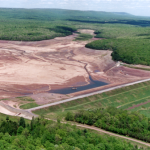
Penn Forest Dam (Pennsylvania, 1994)
Penn Forest Dam was constructed between 1956 and 1958 to be one of the main water supply reservoirs for the city of Bethlehem, Pennsylvania. The dam was originally an earthfill embankment structure, stood 145 feet high, 1,930 feet long, and stored 6.4 billion gallons of water...
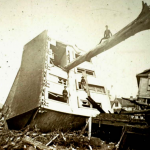
South Fork Dam (Pennsylvania, 1889)
South Fork Dam was an earth- and rock-fill dam located about 8 miles east of Johnstown, PA. Originally constructed in 1852, the dam’s primary purpose was to provide a source of water for a division of the Pennsylvania Canal. The dam was approximately 72 feet high...
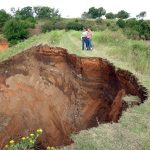
Sugar Creek Watershed Dam No. L-44 (Oklahoma, 2007)
Sugar Creek Watershed Dam No. L-44 (Sugar Creek Dam) is located approximately four miles northwest of Anadarko in Caddo County, Oklahoma. It is one of 51 flood control dams in the Sugar Creek watershed.
Best Practices

Technical Manual: Conduits through Embankment Dams - Best Practices for Design, Construction, Problem Identification and Evaluation, Inspection, Maintenance, Renovation, and Repair
Author: Federal Emergency Management Agency
Date Published: 2005
Other Resources

ACER TM No. 3 - Criteria and Guidelines for Evacuating Storage Reservoirs and Sizing Low-Level Outlet Works
Author: Bureau of Reclamation
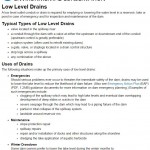
Low Level Drains
Author: New York State Department of Environmental Conservation
NYDEC online resource
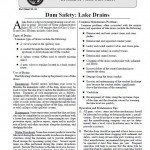
Dam Safety: Lake Drains, Fact Sheet 93-26
Author: Ohio Department of Natural Resources
Fact Sheet published by ODNR

No Drain to Pull? Well that Sucks! Pennsylvania's Emergency Response Teams May be Able to Help!
Author: R. Reisinger
Technical paper published by Association of State Dam Safety Officials



